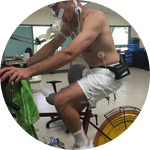About This Project
Obesity & chronic disease are on the rise, so determining effective exercise regimens to combat obesity and improve health is necessary. High intensity interval training (HIIT) increases maximal oxygen uptake (VO2max), overall physical function & health status. Yet, little research has investigated HIIT in obese women. We will compare the effects of 2 HIIT regimens on VO2max, cardiac output, body fat, and muscle strength in obese women.
Ask the Scientists
Join The DiscussionWhat is the context of this research?
Public health guidelines advocate that every adult accumulate 150 minutes per week of moderate physical activity. Despite the fact that regular physical activity improves physical function and reduces risk of every known chronic disease, adherence to exercise is poor, partially due to lack of time. High intensity interval training (HIIT) has been reported to improve physical fitness and health status similar to moderate exercise while being more time-efficient. We propose a novel study comparing adaptations to two HIIT regimes differing in structure in healthy sedentary obese women.
What is the significance of this project?
Individuals with obesity face increased risk of chronic disease including cancer, diabetes, and heart disease. Data show that regular completion of moderate exercise can induce substantial improvements in health status in obese persons in the form of improvements in cardiorespiratory fitness, body composition, and glucose control without dramatic weight loss. However, this mode of exercise is time-intensive and is often viewed as aversive and unpleasant, which tends to reduce adherence and thus magnitude of health-related adaptations. Little data exist showing efficacy of HIIT in obese women, so data from the proposed study will shed light on the effectiveness of HIIT as an exercise countermeasure in this population.
What are the goals of the project?
The goal of this project is to compare changes in physical fitness, cardiac output, body fat, & muscle strength between 2 different HIIT regimens in obese women. The participants will complete 6 weeks of HIIT training. VO2max, cardiac output, body fat & muscle strength will be measure pre-, mid- & post-training to track changes. Another goal of this project is to gauge the feasibility of HIIT performed outside of a lab in a clinical population. We will test the "real-world" suitability of HIIT by requiring the participants to perform one training session per week on their own. This is a novel aspect of the study, as it is unclear if HIIT can be easily and properly performed by participants outside a supervised lab setting.
Budget
Part of this budget will go towards a financial incentive ($4,000 = 20 women X $200.00 per participant) to partially defray the costs of time and travel to our facility to complete all requirements of the study. Consumable supplies in the form of 1 box of electrodes equal to $500.00 will also be purchased to measure cardiac output. We have no other funding to support this project.
Endorsed by
Meet the Team
Affiliates
Team Bio
My collaborators are my 2 outstanding Master's students, Amy Clark and Annie De La Rosa, who will be conducting the study. They have substantial experience in exercise testing and human subjects research and are eager to initiate this project under my direction.
Todd A. Astorino Ph.D
I am the Graduate Coordinator in the Dept. of Kinesiology at California State University--San Marcos. Over the last 9 yr, I have led three long-term studies investigating health-related adaptations to HIIT in various populations. I have a Ph.D in Exercise Physiology from the University of New Mexico and have authored over 50 peer-reviewed papers in scientific journals.
Annie De La Rosa
I am a current graduate student in the Department of Kinesiology at California State University - San Marcos. I have a Bachelors degree in Kinesiology from Michigan State University, where I had the opportunity to be an intern for the Human Energy Resource Lab. My internship allowed me to work as a research associate on multiple research projects, fueling my passion for exercise physiology.
Amy Clark
I am current graduate student in the department of Kinesiology at California State University of San Marcos. I have a Bachelors degree in Kinesiology from California State University of San Marcos. During my undergraduate studies I had the opportunity to work in the Exercise Physiology lab and the Motor Control and Learning lab where I was fortunate enough to work on several studies. As I became more involved in Exercise Physiology my passion for the subject grew along with an interest in preventive medicine through exercise.
Project Backers
- 13Backers
- 16%Funded
- $714Total Donations
- $54.92Average Donation



